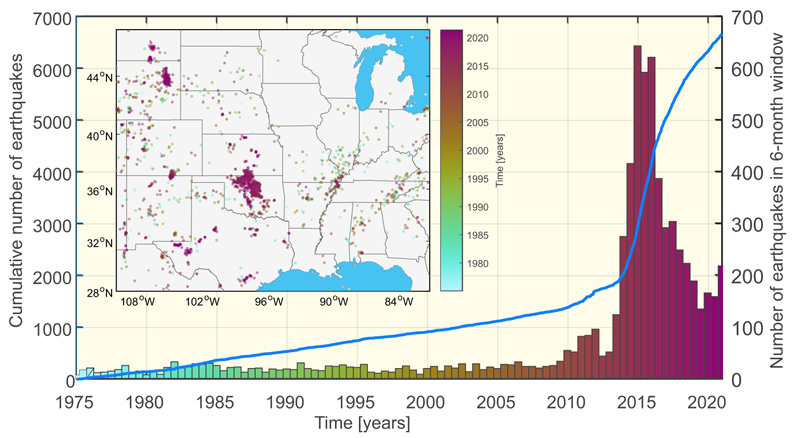Many activities required to power and sustain human society have the potential to create earthquakes. This is known as ‘induced seismicity’. Historically, the first observations of induced seismicity were connected to mass displacement, such as during gold mining in South Africa as early as 1894, and coal mining.
Many activities required to power and sustain human society have the potential to create earthquakes.
Another cause is reservoir impoundment for water supply and power generation, such as the Lake Meade, Hoover Dam M 5 event in 1939 (Foulger et al. 2018). The largest detected induced event to date was the M 6.3 Koyna earthquake in 1967 (Gupta et al. 2015). This is set to continue with more than 3,500 dams presently being built or planned (Zarfl et al., 2019).
Meanwhile, components of renewable energy technologies such as wind turbines, solar cells, and batteries, require a variety of minerals and metals; thus, new mines will be developed in the forthcoming decades to extract these needed resources (Mining Equipment Market Share & Growth Report, 2020-2027).
Induced seismicity can also be caused by underground industrial activities such as geothermal energy, geological sequestration of CO2 (In Salah Project, microseismicity), exploitation of unconventional hydrocarbon reservoirs (Blackpool, M 2.3), and storage of gas in geologic formations (CASTOR UGS project offshore Spain, M 4) to cover seasonally-varying energy demand. These operations require more invasive techniques for fluid injection and production, and increase the risk of seismic activity, sometimes at close proximity to urban centers (e.g. Suckale, 2010; Ellsworth, 2013). Consequently, certain regions such as Oklahoma and Alberta have been experiencing a long-term increase in induced earthquake rates well beyond historic levels with some events causing local damage and destruction (Ellsworth, 2013).

Research is urgently needed to assess whether human-induced seismic hazards can be controlled, and whether an improved understanding of the underlying physical processes may help mitigation efforts.
Project developers and regulators thus face increasing public awareness and concern about the damaging potential of induced seismicity. Owing to public opinion pressure, human-induced earthquakes have often forced rapid termination of subsurface activities (for example, coal mining in the German Ruhr Area, the Basel geothermal project in Switzerland, and the CASTOR Underground Gas Storage in Spain). Research is therefore urgently needed to assess whether human-induced seismic hazards can be controlled, and whether an improved understanding of the underlying physical processes may help mitigation efforts.
One of the key outstanding questions is whether it is possible to control or reduce induced seismicity rates and maximum magnitudes in order to mitigate the resulting risk to society and critical infrastructures (e.g. McGarr 2014; Galis et al., 2017; McGarr and Barbour, 2018; Kwiatek et al., 2019; Shapiro et al., 2013; Shapiro et al., 2011; van der Elst et al., 2016). There is a clear need for improved seismic hazard assessment and operational forecasts of induced seismicity for different types of subsurface operations and tectonic settings.
General mechanisms controlling the occurrence of induced seismicity include elastic loading and unloading and modification of pore fluid pressure and stress conditions due to fluid injection and production in reservoirs and surrounding rocks (Segall, 1992). Although pore pressure increase and effective stress reduction have traditionally been thought to produce most induced events, recent observations suggest a more complex suite of mechanisms. Sudden rate changes and long-range effects highlight the importance of the interplay between fluid pressure and solid stress (e.g. Rudnicki, 1986; Segall and Fitzgerald, 1998; Altmann et al., 2014; Goebel et al., 2017). Shallow faults may promote aseismic deformation which can trigger seismic events at larger distances (Cornett et al., 1997; Bourouis et al., 2007; Guglielmi et al., 2015). Fluid flow can trigger earthquakes and potentially lead to cascading failure of fault systems leading to a series of seismic events (Llenos and Michael, 2013; Sumy et al., 2014).
A new cross-journal special collection in JGR: Solid Earth and Earth and Space Science, entitled Understanding and anticipating induced seismicity: from mechanics to seismology solicits papers that contribute to the understanding of induced seismicity at different spatial and temporal scales.
A new cross-journal special collection solicits papers that contribute to the understanding of induced seismicity at different spatial and temporal scales.
Induced seismicity research involves many different disciplines from geomechanics and engineering to seismology and geodesy, requiring a broad suite of analytical, numerical, and statistical analysis tools to improve theoretical understanding and disaster mitigation. The special collection encourages contributions on current scientific challenges in an effort to advance physical process understanding at different scales from laboratory to mesoscale injection tests and reservoir to regional-scale models and observations.
—Birgit Müller ([email protected], ![]() 0000-0002-5668-1437), Karlsruhe Institute of Technology, Germany; Mai-Linh Doan, (
0000-0002-5668-1437), Karlsruhe Institute of Technology, Germany; Mai-Linh Doan, (![]() 0000-0002-6437-9756), Université Grenoble-Alpes, France; Thomas Goebel (
0000-0002-6437-9756), Université Grenoble-Alpes, France; Thomas Goebel (![]() 0000-0003-1552-0861) The University of Memphis, USA; Yajing Liu (
0000-0003-1552-0861) The University of Memphis, USA; Yajing Liu (![]() 0000-0002-5323-8077), McGill University, Canada; Patricia Martínez-Garzón (
0000-0002-5323-8077), McGill University, Canada; Patricia Martínez-Garzón (![]() 0000-0003-4649-0386), GFZ German Research Centre for Geosciences, Germany; Tom Mitchell (
0000-0003-4649-0386), GFZ German Research Centre for Geosciences, Germany; Tom Mitchell (![]() 0000-0003-0809-1528), University College London, UK; and Ilia Zaliapin (
0000-0003-0809-1528), University College London, UK; and Ilia Zaliapin (![]() 0000-0001-6257-0517), University of Nevada, USA
0000-0001-6257-0517), University of Nevada, USA
Citation:
Müller, B., M.-L. Doan, T. H. Goebel, Y. Liu, P. Martínez-Garzón, T. Mitchell, and I. Zaliapin (2021), Understanding and anticipating induced seismicity, Eos, 102, https://doi.org/10.1029/2021EO161325. Published on 30 July 2021.
Text © 2021. The authors. CC BY-NC-ND 3.0
Except where otherwise noted, images are subject to copyright. Any reuse without express permission from the copyright owner is prohibited.

